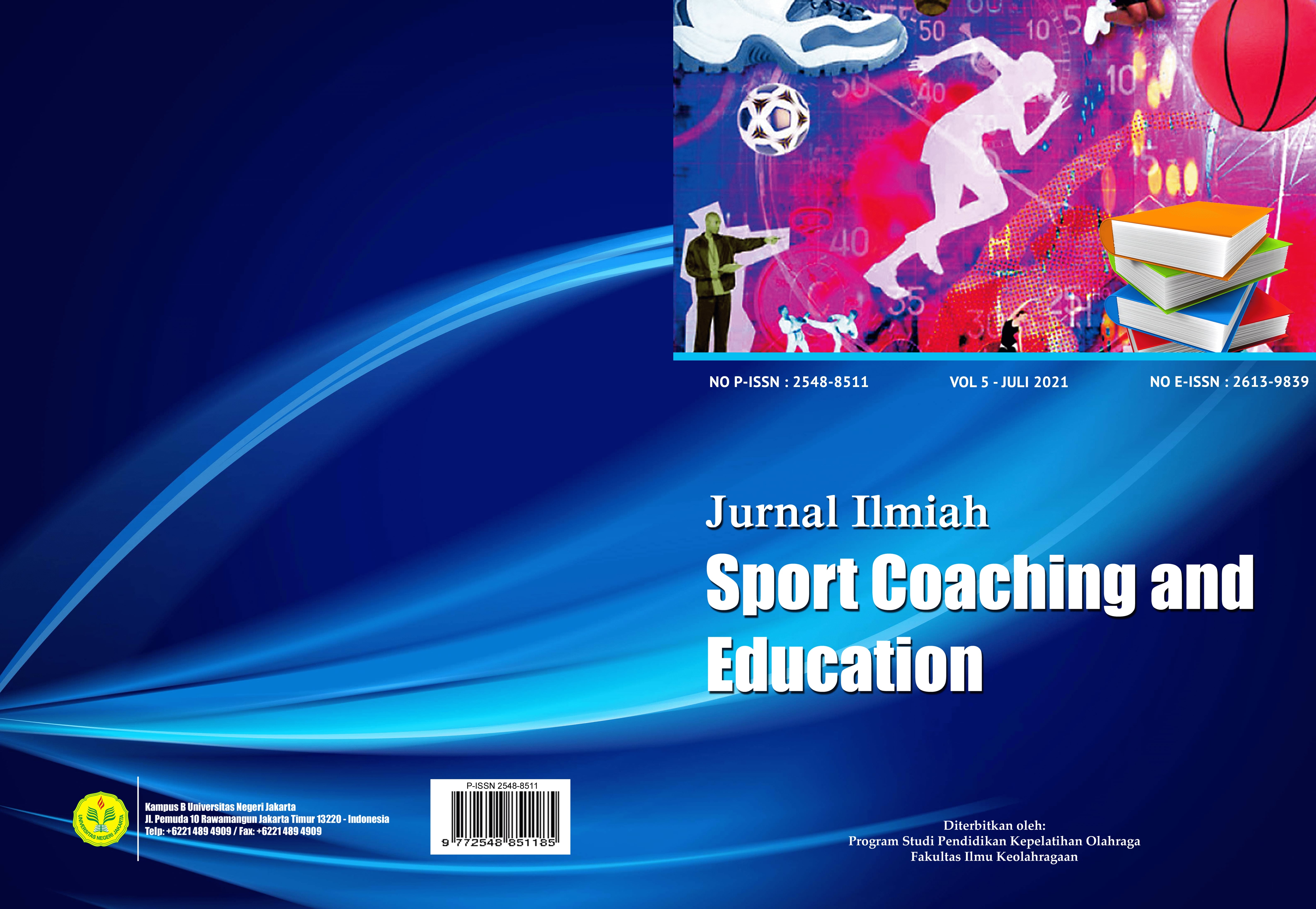Perbandingan Rating of Perceived Exertion (RPE) Tes Balke Dan Tes Jalan Rockport Dalam Pengukuran VO2 Max
DOI:
https://doi.org/10.21009/JSCE.05214Keywords:
RPE, Rating of Perceive Exertion, Vo2max, Rockport, BalkeAbstract
ABSTRAK
Penelitian ini bertujuan untuk mengetahui Rating of Perceive Exertion (RPE) yang dihasilkan antara tes pengukuran VO2 Max metode tes Balke 15 Menit dan Tes Jalan Rockport 1600 Meter. Penelitian ini merupakan penelitian studi komparatif dengan teknik pengumpulan data menggunakan tes dan pengukuran. Populasi dalam penelitian ini adalah mahasiswa Fakultas Ilmu Keolahragaan Universitas Negeri Jakarta yang memiliki kriteria aktivitas fisik sedang dan berat. Sampel yang diambil menggunakan teknik purposive sampling berjumlah 15 orang. Instrumen yang digunakan untuk mengukur Rating of Perceive Exertion (RPE) yaitu The Borg RPE Scale dan data dianalisis menggunakan uji T. Simpulan penelitian menunjukkan terdapat perbedaan yang berarti antara nilai RPE yang dihasilkan oleh Tes Balke Dan Tes Jalan Rockport pada subjek penelitian (8,71±0,47 vs 4,14±1,35) dengan P value sebesar 0,000 < α = 0.05).
Kata Kunci: RPE, Rating of Perceive Exertion, VO2 Max, Rockport, Balke
ABSTRACT
This study aims to determine the Rating of Perceive Exertion (RPE) between the VO2 Max measurement Test with the 15 Minute Balke Test method and the 1600 Meter Rockport Walking Test. This research is a comparative study with data collection techniques using Tests and measurements. The population in this study were Faculty of Sports Sciences, State University of Jakartastudents who had moderate and heavy physical activity criteria. The samples taken purposive sampling techniques amounted to 15 people. The instrument used to measure the Rating of Perceive Exertion (RPE) is The Borg RPE Scale and the data were analyzed using the T Test. The conclusions of the study indicate that there is a significant difference between the RPE values by the Balke Test and the Rockport Road Test on the research subjects (8.71 ±0.47 vs 4.14±1.35) with a P value of 0.000 < = 0.05).
Keyword: RPE, Rating of Perceive Exertion, VO2 Max, Rockport, Balke
References
Astrand PO, Rodahl K. Textbook of Work Physiology: Physiological Bases of Exercise. 4th ed. Champaign, Ill: Human Kinetics Inc (2003).
Balke B. A simple field Test for the assessment of physical fitness. Civil Aeromedical Research Institute Report, 63-18. Oklahoma City: Federal Aviation Agency (1963).
British Association of Sports Science. (Sports Physiology Section) Position Statement on the Physiological Assessment of the Elite Competitor, Second Edition (1988).
Burger, S.C. et al. Assessment of the 2.4 km run as a predictor of aerobic capacity. S Afr Med J. 15 (78), p. 327-329. (1990).
Cooper KH. A means of assessing maximum oxygen intake. JAMVA; 203: 135-38. (1968).
Cooper, K. H., The New Aerobics. Bantam Books Inc., New York (1970).
Fernhall B, Millar AL, Tymeson GT. Maximal exercise Testing of mentally retarded adolescents and adults: reliability study. Arch Phys Med Rehabil ;71:1065-1068 (1990).
Horwill F. Obsession for Running - A Lifetime in Athletics. London: Colin Davies Printers, (1991).
Kenney, WL., editor. ACSM’s Guidelines for Exercise Testing and Prescription. 6. Baltimore (MD): American College of Sports Medicine; p. 73 (1995).
Kilne, G. et al. Estimation of VO2 max from a one mile track walk, gender, age and body weight. Med Sci. Sports Exerc., 19, p. 253-259 (1987).
Ramsbottom R, Brewer J, Williams C. A progressive shuttle run Test to estimate maximal oxygen uptake. Br 1 Sports Med; 22: 141 44. (1988).
Rowell, L. B., Taylor, H. L. and Wang, Y., "Limitations to prediction of maximal oxygen intake". Journal of Applied Physiology 19 (5): 919-927 (1964).



